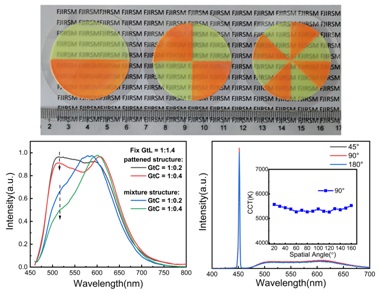Phosphor-in-glass(PiG) has plenty of advantages such as low cost, composition design flexibility, and great combination of multicolor phosphors co-sintered with glass to achieve chromaticity-tunable lighting source. It has been expected as an excellent choice for the laser lighting device. It has received great attention from academia and industry in recent years.
In particular,PiG is co-sintered in the form of thick film on a high-TC substrate (e.g., sapphire or AlN) to form an integrated composite material which inherits the admirable merits of PiG. Meanwhile, the integral thermal conductivity(TC) of PiGF-on-substrate can be improved to be comparable to high-quality ceramic counterparts, thus increasing the luminescence saturation threshold; Therefore super high luminous performance can be achieved in the PiGF-based LD-driven lighting source, and PiG shows great application prospects.
In a study published in Laser & Photonics Reviews, the research group led by Prof. WANG Yuansheng and Prof. LIN Hang from Fujian Institute of Research on the Structure of Matter of the Chinese Academy of Sciences obtained a new pattern structure fluorescent glass ceramics integrated composite material based on reasonable material/geometric configuration design and low temperature co-firing route preparation: CaAlSiN3:Eu2+PiGF-Lu3Al5O12:Ce3+PiGF on high thermal conductivity sapphire substrate.
The researchers found that the luminescence saturation behavior of Lu3Al5O12:Ce3+ is almost determined by the thermal quenching mechanism, while CaAlSiN3:Eu2+ is affected by both the thermal quenching and the intensity quenching mechanism. Heat dissipation of high thermal conductivity sapphire substrate "heat sink" and the pulse rotatory excitation mode, greatly reduce thermal load and retard the occurrence of luminescence saturation.
Systematic experiments combined with theoretical calculations showed that the photon reabsorption phenomenon in the conventional “phosphor mixture” design is well solved by introducing a smart “phosphor pattern” design, “the contradiction between luminosity and chromaticity” seems partly alleviated, and free of causing inhomogeneous angular color distribution at the same time.
Furthermore, the researchers built a universal spectral computation model to predict the luminescent behavior in PiG system containing photon reabsorption effect. The constructed LuAG:Ce PiGF-based green lighting source driven by laser yields high brightness of 2970 lm@21 W mm-2, and the constructed LuAG:Ce PiGF-CASN:Eu PiGF-based white lighting source yields bright white light with luminous flux higher than 1000 lm and color rendering index >80.
This study demonstrates an effective approach to balance luminosity and chromaticity, and paves an avenue to high-quality laser-driven lightings.

Illustration of the Research(Image by Prof. WANG’s group)
Contact:
Prof. WANG Yuansheng
Fujian Institute of Research on the Structure of Matter
Chinese Academy of Sciences
Email: yswang@fjirsm.ac.cn